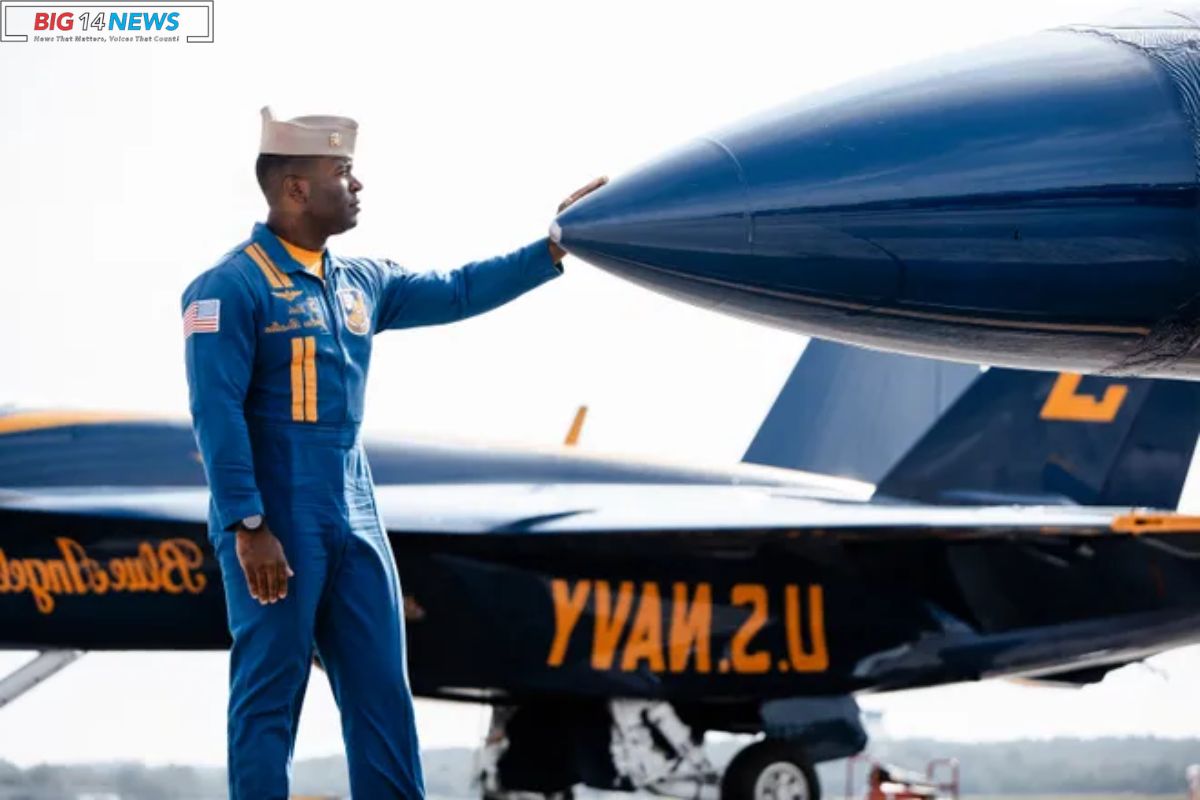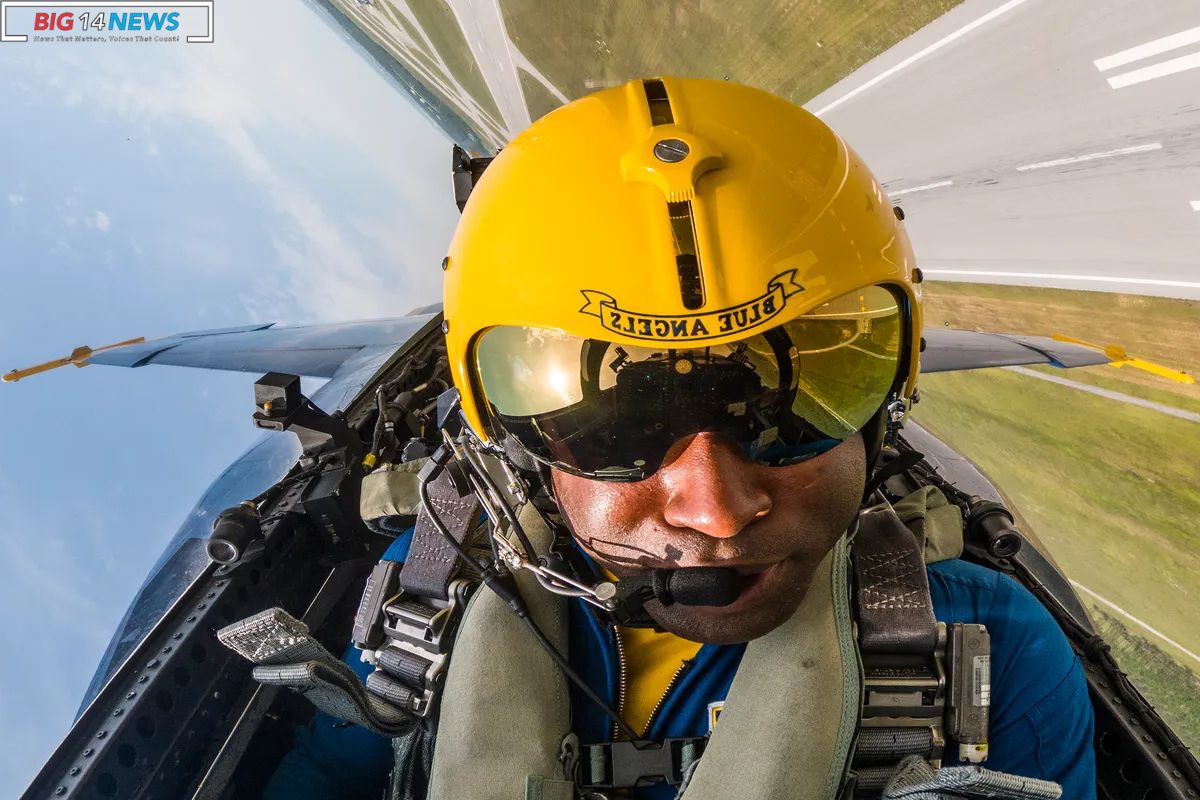Pensacola bids farewell to Blue Angels: The deep blue sky over Naval Air Station Pensacola witnessed a display of aerobatic skill and courage on November 4 as Navy Lt. Cmdr. Julius “Whiskers” Bratton completed his final flight as a Blue Angel pilot. The homecoming show marked the end of Bratton’s tenure, with the famous No. 5 jet streaking across the sky for the last time, leaving behind a trail of cherished memories and inspiration for fans worldwide.
Bratton’s journey to secure a coveted spot in the Blues squadron began in 2019, following the path of every other Blue Angel pilotflying on and off aircraft carriers. Serving with Navy squadron VFA-86, known as the Sidewinders, he earned his call sign “Whiskers,” reflecting the inquisitiveness of a cat.
“I asked a lot of questions,” he recalled with a grin.
During his deployment with the Sidewinders in 2015, Bratton flew combat missions into Iraq and Syria from the USS Dwight D. Eisenhower, supporting Operation Inherent Resolve.
Hailing from Woodlawn, Tennessee, Bratton attended the U.S. Naval Academy in Annapolis, Maryland, graduating in 2011 with a commission as an ensign in the U.S. Navy. Completing intermediate and advanced flight training at Naval Air Station Meridian, Mississippi, he earned his Wings of Gold in 2013.
Joining the Blue Angels in 2020 as the No. 7 media pilot and show narrator, Bratton continued in that role for an additional year due to the pandemic. In the 2022 season, he transitioned to the opposing solo position in the No. 6 jet, immortalized in a season-long IMAX film about the Blue Angels squadron.
As the lead solo and operations officer flying the No. 5 jet for the 2023 season, Bratton, along with his wingman Lt. Cmdr. Griffin Stangel, showcased remarkable skills through maneuvers like the Knife-Edge Pass, Opposing Minimum Radius Turn, the Tuck Over Roll, and the infamous Sneak Pass.


ALSO READ: Airbus Transatlantic Fleet with Greener Tech: Flettner Rotors and E-Methanol for Lower Emissions
“As solos, we are like a sponge for the demo,” Bratton explained. “We’re gonna try and keep the consistency and the metronome between the Diamond and the solos. All solo maneuvers are full stick deflections laterally,” he added, emphasizing their aggressive flying style.
“As 5, you’ve been on the team the longest and you can be a mentor and the shepherd,” Bratton continued. “Our opposing solo’s routine is all about precision and timing,” he described, highlighting the high-speed passes, high-G vertical pitch climb-outs, and low-altitude maneuvers.
Cmdr. Jon Fay, the executive officer of the 2023 team, emphasized the pilots’ ability to compartmentalize and block out distractions during dangerous maneuvers.
Reflecting on his inspiration to become an aviator, Bratton shared, “My dad took me to a fly-in in Tuskegee, Alabama when I was 5. That was my first memory of flying in the backseat of a plane. And from that moment on, I was like, ‘This is what I want to do.'”
As an African-American pilot, Bratton acknowledged the importance of representation, providing an extra level of relatability. “The military is a melting pot, and we are fortunate that all of our country’s demographics are represented,” he stated.
One of Bratton’s most memorable Sneak Passes occurred during the Red, White, and Blues air show on Pensacola Beach last July, leaving beachgoers in awe. Pensacola native and photographer Craig Wood captured the spectacular moment, immortalizing Bratton’s No. 5 jet skimming the ocean surface at over 700 miles per hour.
As Bratton smoothly landed his blue and gold jet for the last time on November 4, the crowd cheered on as the torch was passed to his wingman Lt. Cmdr. Stangel, now in the prestigious role of lead solo pilot for the 2024 season.


Bratton leaves behind a legacy as a true aviation rockstar and ambassador of goodwill. The awe-inspiring images from his tenure with the Blues immortalize his daring maneuvers, synchronized precision, and unwavering dedication to excellence.
“I think I’m at the point now where I’ve done about all that I really want to do,” Bratton expressed gratefully. “I’ve gotten the experiences, been there, got the T-shirt, so to speak.”
Also Read: Georgia Bulldogs Under the Lights: Showdown with Georgia Tech in Clean Old Fashioned Hate
Our Reader’s Queries
How hard is it to join the Blue Angels?
Each year, 17 officers and close to 100 enlisted men and women willingly join the Blue Angels team. These members are a diverse and skilled reflection of their counterparts in the fleet, and the selection process is highly competitive. Each individual squadron member is chosen carefully.
How long do Blue Angels serve?
Blue Angels officers are chosen based on their professional expertise, military demeanor, and strong communication abilities. They exemplify the well-rounded nature of their fleet counterparts. Typically, officers serve a two-year term with the team before returning to the fleet.
How close to Blue Angels get?
Ensuring this level of trust is crucial when pilots such as the Blue Angels fly in precision formations with only 18 inches of separation. U.S. Navy Lt. Cmdr. (Dr.) emphasized the exceptional trust required for this remarkable feat.
Where are the Blue Angels right now?
During air show season, the team is based at Forrest Sherman Field, Naval Air Station Pensacola, Florida. From January to March, the squadron trains at Naval Air Facility El Centro, California.

